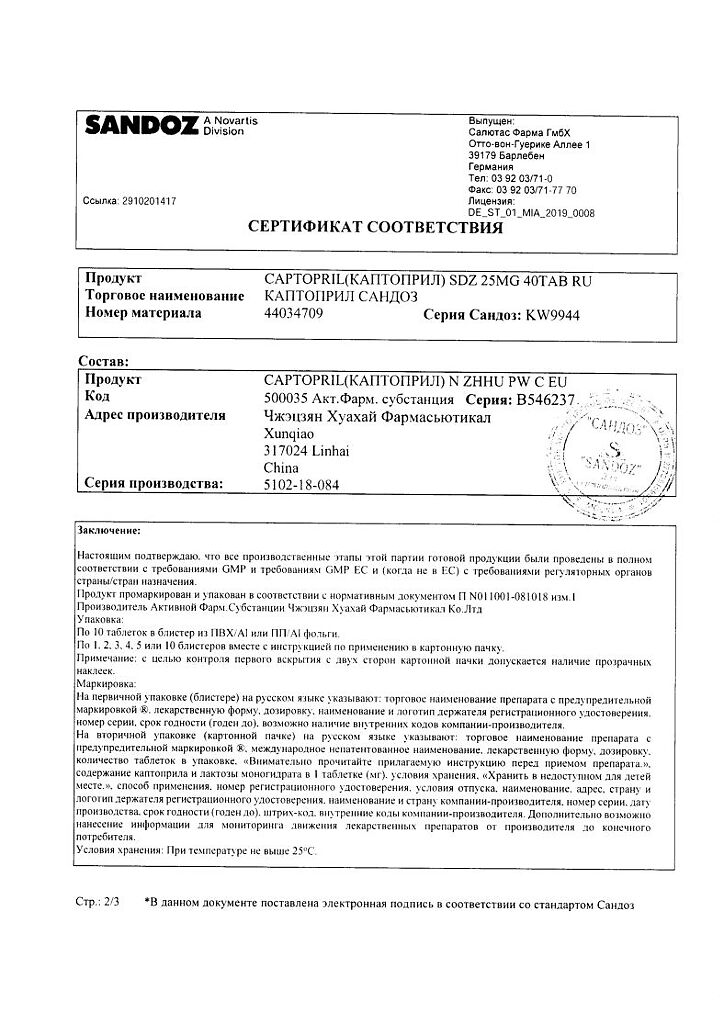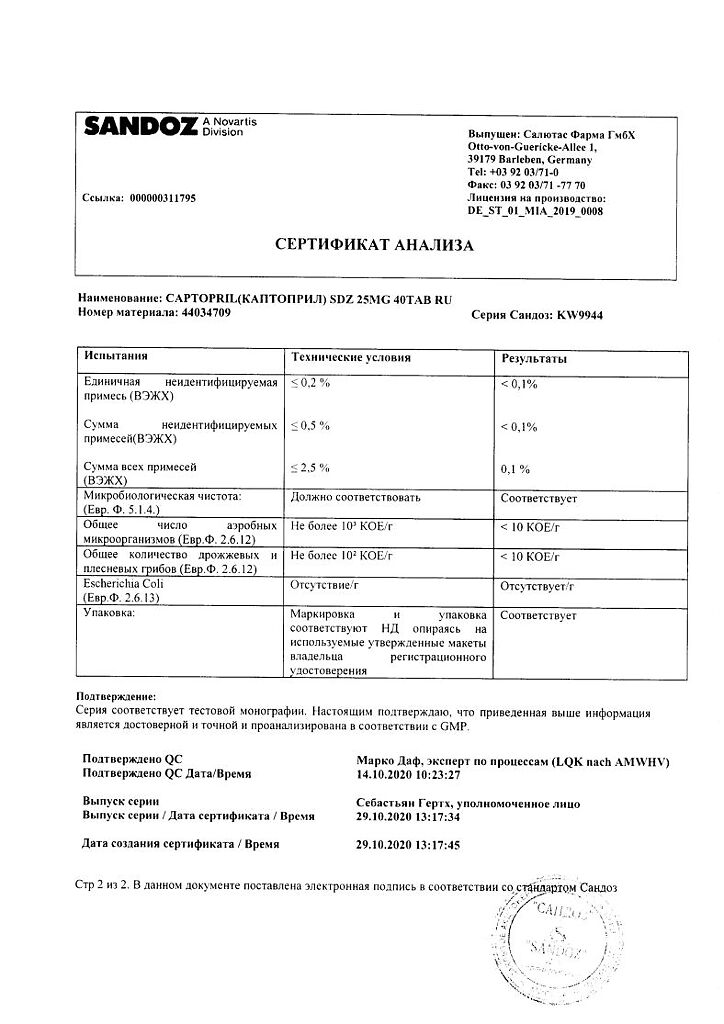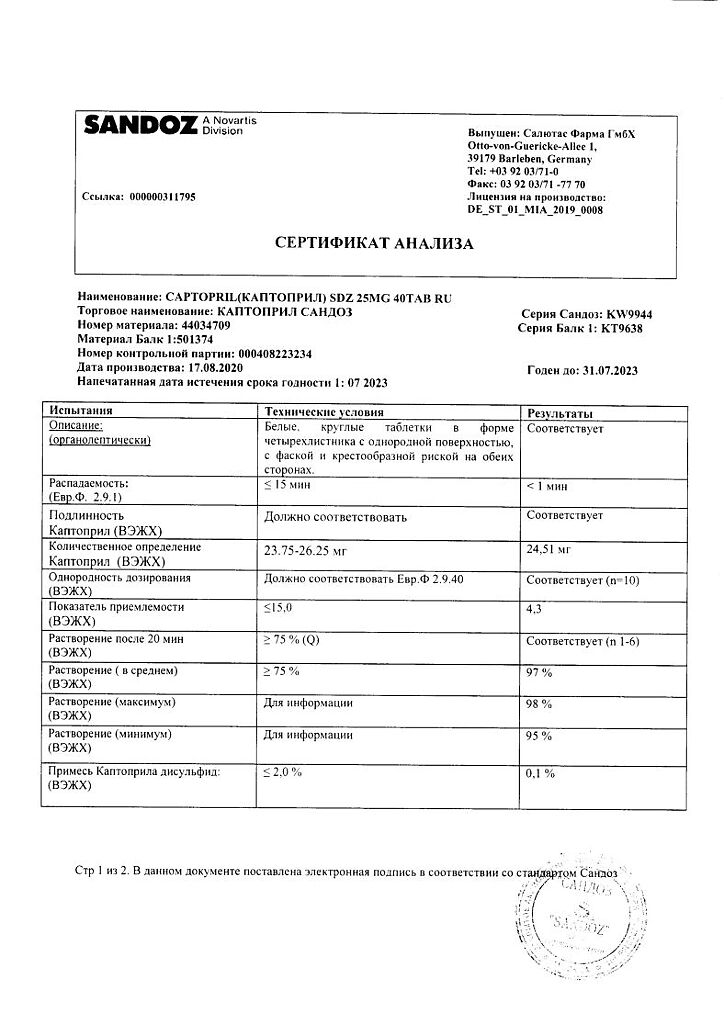No products in the cart.
Captopril Sandoz, tablets 25 mg 40 pcs
€1.00
Out of stock
(E-mail when Stock is available)
Description
A ACE inhibitor. Reduces the formation of angiotensin II from angiotensin I. Reduction of angiotensin II leads to a direct reduction of aldosterone release.
In doing so, it decreases the OPPS, BP, post- and preload on the heart. Dilates arteries to a greater extent than veins. Causes reduction of bradykinin degradation (one of the effects of ACE) and increased synthesis of Pg. The hypotensive effect does not depend on the activity of plasma renin; a decrease in BP is noted at normal and even reduced concentrations of the hormone, which is due to the effect on the tissue renin-angiotensin systems.
It increases coronary and renal blood flow. With prolonged use it reduces the severity of myocardial hypertrophy and resistive arterial walls. Improves the blood supply to the ischemic myocardium. Reduces platelet aggregation. Helps reduce Na+ in patients with CHF. In doses of 50 mg/day it shows angioprotective properties against microcirculatory blood vessels and allows to slow down the progression of CVD in diabetic nephroangiopathy.
The decrease of BP in contrast to direct vasodilators (hydralazine, minoxidil, etc.) is not accompanied with reflex tachycardia and leads to reduction of myocardial oxygen demand.
In CH, an adequate dose has no effect on BP. Maximum BP reduction after oral administration is observed in 60-90 min. The duration of hypotensive effect is dose-dependent and reaches optimal values within several weeks.
Indications
Indications
– Arterial hypertension (including renovascular).
– Chronic heart failure (as part of combination therapy).
Active ingredient
Active ingredient
Composition
Composition
Tablets.
1 tablet contains:
Active substance:
25 mg captopril.
Associates:
Microcrystalline cellulose,
Milk sugar,
corn starch,
magnesium stearate.
How to take, the dosage
How to take, the dosage
Captopril is prescribed one hour before meals. Dosing regimen is established individually. In arterial hypertension the drug is prescribed in the initial dose of 25 mg 2 times a day.
If necessary the dose is gradually (at intervals of 2-4 weeks) increased until the optimal effect is achieved. In mild to moderate arterial hypertension, the usual maintenance dose is 25 mg 2 times a day; the maximum dose is 50 mg 2 times a day. In severe arterial hypertension, the maximum dose is 50 mg 3 times daily. The maximum daily dose is 150 mg. For treatment of chronic heart failure Captopril is prescribed in cases when the use of diuretics does not provide an adequate effect.
The average maintenance dose is 25 mg 2-3 times daily. Further, if necessary, the dose is gradually (at intervals of at least 2 weeks) increased. Maximum dose is 150 mg per day. In patients with impaired renal function with moderate degree of renal impairment (creatinine clearance at least 30 ml/min/1.73 m 2 ) Captopril can be prescribed in dose of 75-100 mg/day.
In more severe renal impairment (creatinine clearance less than 30 mL/min/1.73 m 2 ) the initial dose should be no more than 12.5-25 mg/day; thereafter, if necessary, the dose of Captopril is gradually increased at sufficiently long intervals, but a lower than usual daily dose of the drug is used.
Interaction
Interaction
Diuretics and vasodilators (e.g., minoxidil) potentiate the hypotensive effect of Captopril. When co-administering Captopril with indomethacin (and possibly with other non-steroidal anti-inflammatory drugs), a decrease in the hypotensive effect may be observed.
The hypotensive effect of Captopril may be delayed when administered to patients receiving clonidine. Concomitant use with potassium-saving diuretics or potassium preparations may lead to hyperkalemia. Concomitant use of lithium salts may increase serum lithium concentration.
The use of captopril in patients taking allopurinol or procainamide increases the risk of neutropenia and/or Stevens-Johnson syndrome. The use of captopril in patients taking immunosuppressants (e.g., cyclophosphacin or azathioprine ) increases the risk of hematological disorders.
Special Instructions
Special Instructions
Key kidney function should be monitored before initiating, as well as regularly during treatment with Captopril. In chronic heart failure the drug is used under close medical supervision.
Captopril is prescribed with extreme caution in patients with diffuse connective tissue diseases or systemic vasculitis; patients receiving immunosuppressants, especially if renal function is impaired (risk of serious infections that cannot be treated with antibiotics). In such cases, peripheral blood counts should be monitored before initiation of captopril, every 2 weeks during the first 3 months of therapy and periodically thereafter.
The drug is used with caution during treatment with allopurinol or procainamide as well as during treatment with immunosuppressants (including azathioprine, cyclophosphamide), especially in patients with impaired renal function. The probability of arterial hypotension during treatment can be reduced if diuretics are discontinued or their dose is significantly reduced 4-7 days before initiation of therapy with Captopril.
In case of symptomatic arterial hypotension after administration of Captopril, the patient should assume a horizontal position with elevated legs. In case of severe arterial hypotension a positive effect is noted with intravenous administration of isotonic sodium chloride solution.
In case of development of angioedema the drug is discontinued and close medical observation is carried out. If the swelling is localized to the face, no specific treatment is usually required (antihistamines may be used to relieve symptoms); if it spreads to the tongue, pharynx or larynx and there is danger of airway obstruction, epinephrine should be given subcutaneously (0.5 ml dilution 1:1000) immediately.
With caution, use in patients with a history of renal disease because there is an increased risk of proteinuria. In such cases, the amount of protein in the urine should be monitored monthly during the first 9 months of treatment with Captopril .
If the urine protein level exceeds 1 g/day, the appropriateness of further use of the drug should be decided. Caution is used when prescribing Captopril to patients with renal artery stenosis as there is a risk of renal dysfunction; if the blood levels of urea or creatinine increase, the dose of Captopril may need to be reduced or the drug cancelled.
Contraindications
Contraindications
– Quincke’s edema (including history of ACE inhibitors).
– Severe renal dysfunction.
– Azotemia.
– Hyperkalemia.
– Bilateral stenosis of the renal arteries or stenosis of the sole kidney with progressive azotemia.
– Condition after renal transplantation.
– Primary hyperaldosteronism.
– Aortic orifice stenosis.
– Mitral stenosis.
– The presence of two obstructions to blood flow from the left ventricle of the heart.
– Hypersensitivity to captopril and other ACE inhibitors.
– Severe impairment of liver function.
– Arterial hypotension.
– Cardiogenic shock.
– Childhood under 18 years of age.
Side effects
Side effects
Cardiovascular system: tachycardia, marked BP decrease, orthostatic hypotension, peripheral edema.
Nervous system disorders: dizziness, headache, ataxia, paresthesia, somnolence, visual impairment.
Urinary system disorders: impaired renal function.
Hematopoietic disorders: neutropenia, anemia, thrombocytopenia, agranulocytosis.
Allergic reactions: angioedema of the extremities, face, lips, mucous membranes, tongue, pharynx and larynx, and small intestine (very rare).
Digestive system disorders: taste disorders, dry mouth, stomatitis, abdominal pain, diarrhea, increased liver transaminases activity, hyperbilirubinemia, hepatitis.
Respiratory system disorders: “dry” cough that resolves after discontinuation of the drug, bronchospasm, pulmonary edema.
Laboratory parameters: hyperkalemia, hyponatremia, proteinuria, increased urea nitrogen, hypercreatininemia, acidosis, appearance of antinuclear antibodies in blood.
There have been reported cases of hypoglycemia in patients with diabetes mellitus who were taking insulin and oral hypoglycemic drugs.
Overdose
Overdose
Symptoms: severe arterial hypotension, up to collapse, myocardial infarction, acute impairment of cerebral circulation, thromboembolic complications.
Treatment: lay the patient with the lower extremities elevated; measures aimed at restoring blood pressure (increase in circulating blood volume, including intravenous infusion of isotonic sodium chloride solution), symptomatic therapy. Hemodialysis may be used; peritoneal hemodialysis is ineffective.
Similarities
Similarities
Additional information
| Shelf life | 2 years |
|---|---|
| Conditions of storage | Store in a dry place, protected from light, at a temperature not exceeding 25 ° C. |
| Manufacturer | Sandoz, Germany |
| Medication form | pills |
| Brand | Sandoz |
Related products
Buy Captopril Sandoz, tablets 25 mg 40 pcs with delivery to USA, UK, Europe and over 120 other countries.





















